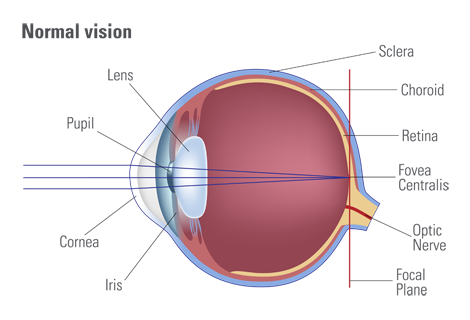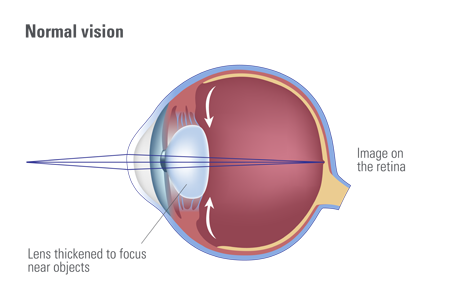
About your vision
|
The eye is often considered the most important sensory organ of the human body. Seventy percent of our sensory cells are located on the retina with the muscles that control eye movement considered to be the most active muscles in the human body. |
The eye is composed of several distinct anatomical structures which include the cornea, lens, pupil, iris, aqueous humor, vitreous humor, sclera, choroid, zonule fibers and retina (Figure 1). |
|
|
|
|
|
|
Figure 1: The structure of the eye. |
Figure 2: Accommodation of the lens. |
|
|
Light enters the eye through the anterior (or front) part of the eye where it passes first through the cornea and then lens which focus the light into a distinct beam. This light beam then moves through the middle of the eye and ends up on the back of the eye (retina) which is compsed of a light-sensitive membrane that translates the light into electrical signals which are, in turn, sent to the brain through the optical nerve (Figure 1). |
The cornea is the outermost transparent layer in the anterior part of the eye and is responsible for most of the focus or dioptric power. The curvature of the cornea determines how well the light is focused. After light leaves the cornea it passes through the lens which is flexible and can change shape to help you see at different distances (accommodation) (Figure 2). |

YOUR VISION
|
Z-LASIK
|
FIND A DOCTOR
|
FOR PROFESSIONALS
|
Important patient information
Ziemer FEMTO LDV lasers are prescription medical devices that can only be used by accredited eye care professionals for LASIK and other approved surgical procedures. Only a trained eye care professional can determine if a FEMTO LDV laser procedure is appropriate for your condition. Talk to your doctor if you have a family history of keratoconus, glaucoma, other eye-related diseases, diabetes, a history of herpes simplex or herpes zoster keratitis, significant dry eye, severe allergies or have had changes in your vision over the past year.
The LASIK (laser-assisted in situ keratomileusis) procedure causes permanent changes to the cornea as a therapy for myopia, hyperopia or other diseases where the cornea is not an optimal shape. You should not have LASIK if you have autoimmune or an immunodeficiency disease, if you are pregnant or nursing, show signs of corneal thinning, or take medications with eye-related side effects, such as Isotretinoin (Accutane®) for acne treatment or Amiodarone hydrochloride (Cordarone®) for cardiac arrhythmia. LASIK is for adults whose vision has stabilized.
Risks associated with the LASIK procedure include: dry eye syndrome, the possible need for glasses or contact lenses after surgery, visual symptoms including halos, glare, starbursts, double vision, other visual irregularities or possible loss of vision. Results may vary for each individual patient.










